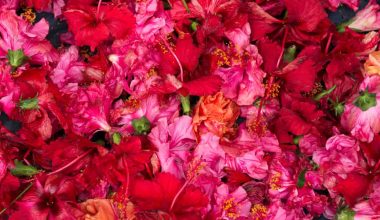If you’ve ever tried to add a touch of greenery to your space, ferns might have caught your eye. They’re lush, graceful, and seem to have a timeless appeal. But are these beauties perennial?
Here, we would break down all you should know about ferns and figure out if they’re the forever friends you’re looking for in your garden.
Table of contents
Are Ferns Perennial Plants?
Yes, ferns are perennial plants. Perennials are plants that live for more than two years, and ferns fit this definition. Ferns are non-flowering vascular plants that reproduce via spores rather than seeds.
They typically have complex leaves known as fronds and can be found in a variety of environments, ranging from forests to wetlands.
Unlike annual plants that complete their life cycle in one growing season and die, and biennials that complete their life cycle in two growing seasons, perennials like ferns continue to live and grow for multiple years, often regenerating from the same root system.
Read also: How to Use a Coping Saw
Where to Plant Ferns?
When deciding where to plant ferns, it’s important to consider their natural habitat and growing conditions. Some suggestions you should consider are-
Shade or Partial Shade:
Most ferns prefer shade or filtered sunlight. They are well-suited for areas of the garden that receive dappled sunlight or are in the shadow of taller plants or structures.
Some fern species can tolerate more sunlight, but in general, they are adapted to lower light conditions.
Moisture:
Ferns often prefer moist soil. They are commonly found in woodland areas or along stream banks where the soil stays consistently damp.
Make sure the soil has good drainage to prevent waterlogging, as too much moisture can lead to root rot.
Soil Type:
Ferns generally prefer rich, organic, and well-draining soil. They are not overly picky about soil pH but tend to do well in slightly acidic to neutral soils.
Woodland Gardens:
Ferns are natural choices for woodland or shade gardens. Plant them under trees or alongside other shade-loving plants to create a lush and textured garden bed.
Containers:
Many ferns can be grown successfully in containers, making them suitable for patios, balconies, or indoor gardens. Use a well-draining potting mix and ensure that the container has drainage holes.
Rock Gardens:
Some fern species are adapted to rocky environments. If you have a rock garden or a garden with well-draining soil, consider incorporating ferns for added interest.
Borders and Edges:
Ferns can be used to soften the edges of pathways or borders. Their feathery fronds add a touch of elegance and can complement other plants in the garden.
You should read: How Heat Pumps Work
Tips for Growing Ferns
Growing ferns can be a rewarding experience, and with the right care, you can enjoy their lush, green foliage in various settings. Here are some tips for growing ferns:
Choose the Right Fern:
Different fern species have varying light, soil, and moisture requirements. Select ferns that are well-suited to the conditions in your garden or the specific location where you plan to plant them.
Light Requirements:
Most ferns prefer shaded or partially shaded areas. While some can tolerate more sunlight, direct sun exposure can often scorch their delicate fronds. Consider the natural habitat of the fern species you have and provide a suitable level of light.
Soil Preparation:
Ferns generally prefer well-draining soil rich in organic matter. They are not too picky about soil pH, but aim for a slightly acidic to neutral range. Incorporate organic matter, such as compost, into the soil before planting.
Moisture Levels:
Ferns thrive in consistently moist soil. Water them regularly, especially during dry periods, to keep the soil consistently damp. However, avoid waterlogging, as excessive moisture can lead to root rot.
Check out this related content: How To Get Mildew Out Of Clothes In Less Time
Mulching:
Apply a layer of organic mulch around the base of ferns to help retain soil moisture and suppress weeds. This is particularly important in the early stages of growth when ferns are establishing themselves.
Fertilization:
Ferns generally don’t require heavy fertilization. Use a balanced, slow-release fertilizer in spring to provide nutrients for the growing season. Avoid over-fertilizing, as ferns are adapted to nutrient-poor soils.
Pruning and Cleaning:
Remove dead or damaged fronds regularly to encourage new growth and maintain the plant’s appearance. Cleaning up debris around the fern can also help prevent pests and diseases.
Protection from Frost:
Some fern species are sensitive to frost. If you live in a colder climate, provide protection during winter months, such as covering ferns with a layer of mulch or moving potted ferns indoors.
Container Care:
If growing ferns in containers, ensure that the pots have drainage holes to prevent waterlogging. Use a well-draining potting mix and water when the top inch of the soil feels slightly dry.
Monitor for Pests and Diseases:
Keep an eye out for common fern pests like aphids, mealybugs, and scale insects. Treat any infestations promptly. Also, ensure good air circulation to prevent fungal diseases.
Consider the Microclimate:
Pay attention to the specific microclimate of the planting site. Factors such as humidity, wind exposure, and nearby structures can influence the health and growth of ferns.
Read also: How to Organize Tools in your Toolbox
What to Expect when growing Ferns?
When growing ferns, you can expect certain characteristics and behaviors that are common to these plants. Generally, you should expect-
Slow Growth:
Ferns generally have a slow to moderate growth rate. It may take some time for them to establish themselves and reach their full size, especially when compared to faster-growing plants.
Lush Foliage:
One of the main attractions of ferns is their lush and feathery foliage. As they grow, they produce fronds with intricate patterns, adding a touch of elegance to your garden or indoor space.
Shade Tolerance:
Most ferns are well-adapted to shaded or partially shaded environments. They have evolved to thrive under the canopy of taller plants or in the understory of forests.
Moisture Requirements:
Ferns prefer consistently moist soil. Adequate watering is crucial, and they may struggle in dry conditions. Mulching around the base of ferns helps retain soil moisture.
Seasonal Changes:
Some fern species may exhibit seasonal changes in appearance. Fronds may unfurl or change color in response to seasonal variations in temperature and light.
Reproduction by Spores:
Ferns reproduce through spores, not seeds. Spore production is often visible on the undersides of mature fronds in structures called sporangia. These spores can be used for propagation.
Winter Dormancy (in Cold Climates):
In colder climates, some ferns may go dormant during the winter months. The fronds may die back, but the plant often regenerates from the rhizome when conditions become favorable again in spring.
Adaptability to Containers:
Many fern species can be grown successfully in containers. This adaptability makes ferns suitable for indoor gardening, balconies, and patios. Container-grown ferns may need more frequent watering than those planted in the ground.
Check out this related content: How to Get Rid of Ground Hornets
Conclusion
Ferns stand out for their timeless charm and enduring presence. The good news? Yes, ferns are indeed perennial, offering a reliable source of green joy in your garden.
Armed with a bit of care knowledge, you can enjoy these leafy companions year after year, making them a fantastic addition to any green space.
Read also: Top 10 Spring Plants you don’t know about
Frequently Asked Questions
Yes, ferns are typically perennial plants. This means they have a life cycle that extends over multiple years. With the right care, ferns can bring green elegance to your garden year after year.
Ferns thrive in shaded, moist environments. Keep the soil consistently damp and provide indirect sunlight. Regular watering and occasional feeding can keep your perennial ferns happy.
Absolutely! Many fern varieties make excellent indoor plants. Choose a location with filtered light, and keep the soil consistently moist. Indoor ferns can add a touch of nature to your home.
While some fern varieties are sensitive to frost and may die back in winter, many are hardy and can survive the cold. Mulching around the base can help protect them during chilly months.
Yes, you can! Ferns are often amenable to division. When they outgrow their space, carefully dig up the plant, divide the root ball, and replant the sections. It’s a great way to propagate and share the fern love.
References
- home.howstuffworks.com- are ferns perennials
- homework.study.com– are ferns perennials plants
- longfield-gardens.com– all about ferns



